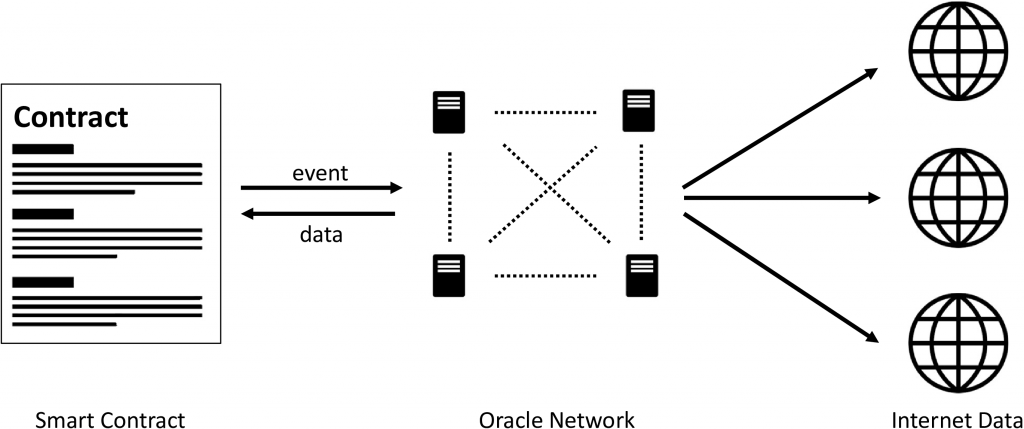Last year was an exciting year. In October 2018 I finally graduated from my Master’s in Computer Science. The topic of my thesis was about Blockchain / Oracle Reputation Systems. When I started to find a topic, I realised the lack of research material and references in the Blockchain space. So, I had to find a topic where I could incorporate previous research papers.
The general question for me about Blockchain and the real-world applicability of smart contract was about how it is possible to incorporate external data securely. Imagine that you want to implement a smart contract based on some external data or event and somebody manipulates that data. You will possibly trigger a payment that is irreversible. As a short wrap-up the data-feeding mechanism for smart contracts is shown in Figure 1. An external computer called oracle, fetches data from an online resource and feeds this data to a smart contract. The oracle can send data continuously or respond to events that were triggered by the smart contract.

After digging through a lot of whitepapers dealing with oracle networks and possible security architectures, I realized that there is not a single solution, but we have to use small pieces that can make the whole system more secure. The main pieces that I identified are:
- Using distributed oracle networks instead of single oracles
- Using multiple data sources
- Using trusted computing environments / hardware extensions
- Using incentivation schemes (for acting honestly)
- Using reputation systems that can help both decision-making and incentivation
To give you a better feeling about my thesis and provide a introduction, the articles are split in two. The first article (this one) will be an introduction about all parts that are necessary to understand my thesis. The second part will then present my methodology and results as well as a conclusion.
Smart Contracts
A smart contract is some piece of code that can enforce an agreement that is coded within it. It can be used to trigger automated payments and lives within a Blockchain. That means it is stored on all participating computing nodes and then executed redundantly on every machine. A possible architecture for the implementation of smart contracts is using a virtual machine that executes the code. A very simple example of a smart contract could be an insurance contract involving weather data. The weather report is constantly sent to the smart contract and if the weather is really bad (e.g. there is a thunderstorm), eligible customers get a compensation automatically.
External Data / Oracle Networks
As already indicated, a real smart contract needs external data (like a weather report, betting results,…). This data could come from online sources – let’s say different weather forecast agencies. As a smart contract cannot fetch data itself yet, the data must be sent proactively by external data providers. These data providers are called oracles. An oracle is an ordinary computing device fetching data and sending it to the smart contract (see again figure 1).
Oracle Security
The main security threat for smart contracts is including external data, as this can trigger unwanted payments. For this issue, common projects such as TownCrier, ChainLink or Witnet suggest using hardware-based trusted computing architectures for oracle nodes. These hardware modules can run code in a secure hardware environment. However, you have to trust the hardware vendor to provide a secure architecture. Having Intel’s meltdown in mind, this was not the best solution for me, but maybe a small piece.
Another component is the use of multiple oracles and multiple data sources. Thinking about this, an oracle network (P2P network) can be formulated itself as a Blockchain where the results of external data is stored within the Blockchain (see Figure 2). As the Blockchain is irreversible, it is always clear, which participating node gave which answer for which request. To get a better intuition, I proposed a block format in my thesis which you can see in Figure 3. The blocks contain the data (answer) for each requested data. For simplicity, I decided to use numerical data, but it wouldn’t be a problem to expand this to text data.


Having a P2P oracle network that fetches data and stores the result into blocks, you might think: Why do we need all of this? The answer lies in identifying malicious peers. The main security threat for a P2P oracle network
Conclusion
In the first article of the two part-series, we have seen the concept of feeding data to a smart contract using oracles. As smart contracts should trigger automated payments (actually that is the idea of a programmed contract), this poses substantial security issues, regarding external data sources and oracles themselves. Solutions for this problem could be small pieces like using secure hardware architectures (mainly Intel SGX is proposed), multiple data sources and setting up a P2P oracle network where participants get an incentive for providing data. By using a Blockchain as a medium to store the node’s answers irreversibly, we get a history of a node’s answers and can use that to calculate a reputation for identifying malicious peers.